Python endswith()方法
silencement
2019-07-04 13:34:463015浏览 · 0收藏 · 0评论

描述
Python endswith() 方法用于判断字符串是否以指定后缀结尾,如果以指定后缀结尾返回True,否则返回False。可选参数"start"与"end"为检索字符串的开始与结束位置。
语法
endswith()方法语法:
string.endswith(suffix[, start[, end]]) # 自Python2.5版本起,还支持接收一个 tuple 为参数 string.endswith(tuple) # 满足tuple任何一个都返回True
参数
suffix -- 该参数可以是一个字符串或者是一个元素This could be a string or could also be a tuple of suffixes to look for.
start -- 字符串中的开始位置。
end -- 字符中结束位置。
返回值
如果字符串含有指定的后缀返回True,否则返回False。
实例
以下实例展示了endswith()方法的实例:
#!/usr/bin/python
string = "this is string example....wow!!!";
suffix = "wow!!!";
print string.endswith(suffix);
print string.endswith(suffix,20);
suffix = "is";
print string.endswith(suffix, 2, 4);
print string.endswith(suffix, 2, 6);
print '-----------------------------'
string1 = 'abc'
string2 = 'xyz'
string3 = 'twz'
for string in [string1,string2,string3]:
print string.endswith(('a','x'))以上实例输出结果如下:
True True True False ----------------------------- True True False

关注公众号,随时随地在线学习